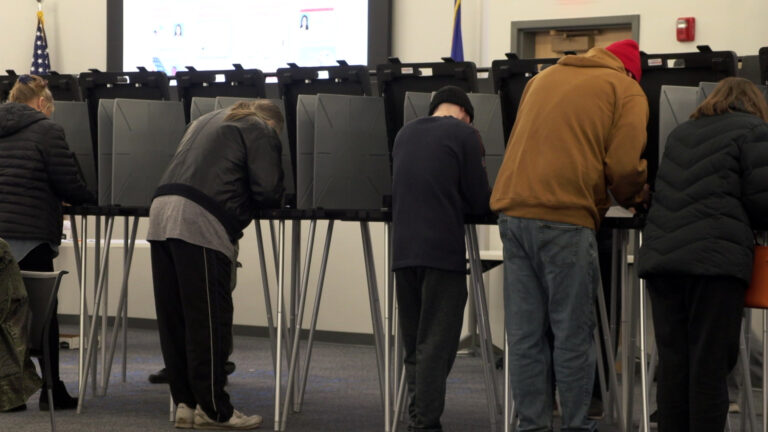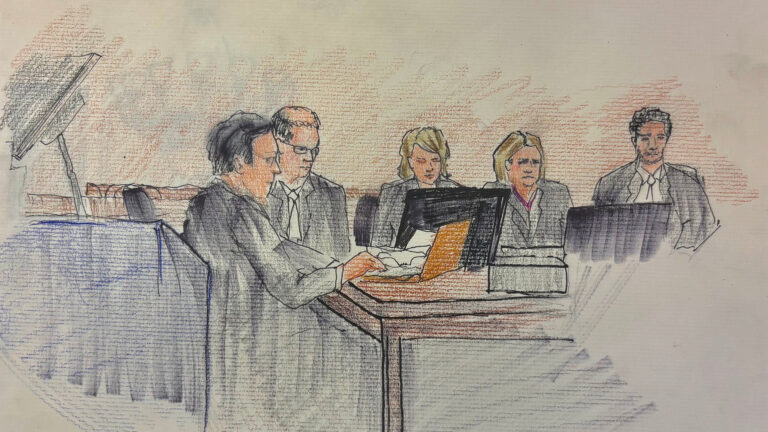'Here & Now' Highlights: Kathryn Halvorsen, Grant Sovern, Lisa Tollefson, Nick Hillman
Here's what guests on the Aug. 22, 2025 episode said about the Red Cross response to flooding in Milwaukee, defending immigration cases, the checks and balances in Wisconsin's voting system, and new limits for federal student loans.
By Frederica Freyberg | Here & Now
August 25, 2025

Frederica Freyberg and Kathryn Halvorsen (Credit: PBS Wisconsin)
The Wisconsin chapter of the American Red Cross put out an urgent call for volunteers in the wake of the Milwaukee flooding, and Kathryn Halvorsen described the work the relief agency does in the aftermath of disasters. Immigration enforcement has sharply increased in Wisconsin, which Community Immigration Law Center attorney Grant Sovern called a dramatic effort to find people who might be deportable. When President Donald Trump said he wanted to ban mail-in voting, state and local election officials rejected the constitutionality of that action — Rock County Clerk Lisa Tollefson walked through the laws in Wisconsin. The One Big Beautiful Bill Act sets new limits on federal student loans, and UW-Madison professor Nick Hillman said the changes will happen quickly.
Kathryn Halvorsen
North Central Wisconsin Executive Director, American Red Cross of Wisconsin
- The Wisconsin chapter of the American Red Cross put out an urgent call for volunteers to sign up for local and national disaster response. Halvorsen said an increase in heavy storms like the torrential rains and flooding that struck Milwaukee in mid-August prompted the call. As representatives of the Federal Emergency Management Agency toured the Milwaukee metro area to assess damage, she described Red Cross work around the city.
- Halvorsen: “We have had volunteers responding around the clock to Milwaukee. Originally, we had opened two shelters and then consolidated to Milwaukee Marshall High School — down to one centralized location that was more accessible to the clients that we were serving there. We were offering everything from a place to stay and eat to charge your phone. People can stay as long or as little as they need. And then on top of that, we were always offering our wraparound services — so mental health support, disaster support, casework recovery, resources outside of us. It takes a huge effort and partnership in the community to be able to help those that needed us most.
How many people have availed themselves of Red Cross services?
Halvorsen: Unbelievable — we had 100 local Wisconsin Red Crossers respond. So, we started as a level three disaster, which is basically still managed by the Wisconsin region. And then we upped it to a level four disaster response operation, so now we’re starting to see that national leadership support, because the need is so great.”
Grant Sovern
Attorney and President, Community Immigration Law Center
- Sovern and other attorneys at the Madison-based Community Immigration Law Center represent people subject to immigration enforcement. He said if people have been following the immigration rules and can get a lawyer to represent them, due process protections are likely to help them prevail against detention and deportation. Still, Sovern said people are afraid because ICE is so motivated to find and detain non-U.S. citizens.
- Sovern: “Everybody is afraid right now, and this is the part the government is trying to make it so difficult. There are maybe 160,000 people in Wisconsin who are not U.S. Citizens, but that goes everywhere from people who have a green card, permanent residence status, a work visa, DACA authorization and unauthorized. How is it that ICE is figuring out by looking at them walking down the street that they might be undocumented? They’re using systems like racial profiling or the accent they have. So any of those people who have those issues are worried, whether or not you’re undocumented, whether or not you have a valid immigration status, and some U.S. citizens who are worried about the current situation, because the government is overextending, going beyond what the legal requirements and abilities are of the government.”
Lisa Tollefson
Rock County Clerk
- President Donald Trump threatened an executive order seeking to abolish mail-in voting and target what he called “highly inaccurate” voting machines, a power that the president does not have. At the same time, his administration is moving to withhold election security funding to states if they don’t follow the federal government’s demands for voting requirements. Election officials note states are responsible for election operations, and take exception to the inaccurate description of mail-in ballots resulting in what Trump calls “massive voter fraud.” Tollefson said she spends a lot of time dispelling such false information.
- Tollefson: “There’s a check and balance through our entire system. Some states mail out absentee ballots to every person. But in Wisconsin, we only mail you an absentee ballot if you have requested it. And to request it, you have to be a registered voter. There’re lots of steps and checks and balances that we go through in the entire system. It’s not randomly, you just mail in a ballot with nothing to back it up — there’s checks all the way through the system.”
Nick Hillman
Professor, UW-Madison School of Education
- Changes to how much students can borrow in federal student loans and how long they have to repay is likely to cause some hardship for undergraduate and graduate students. Hillman said many students don’t know about the new rules, which were included in the One Big Beautiful Bill Act passed by Congress and signed by President Donald Trump.
- Hillman: “I think there’s a lot of confusion. One of the big struggles that I see and I’m hearing about is the timeline of all of these changes are supposed to be taking place — July 1, 2026 — that’s 10 months away, and so prospective students, current students and current borrowers are all wondering. There’s already been several years of a lot of miscommunication, confusion and misunderstanding about the student loan system, and I worry especially as the federal government winds down the Department of Education — has laid off at least 50% of staff at the Department of Education. I’m very concerned about how this will be implemented and how well it will be implemented.”
Watch new episodes of Here & Now at 7:30 p.m. on Fridays.
 Passport
Passport











Follow Us